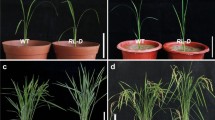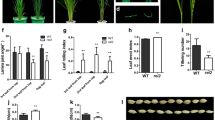Abstract
High-yield cultivars are characterized by erect leaf canopies that optimize photosynthesis and thus favor increased biomass. Upward curling of the leaf blade (called rolled leaf) can result in enhanced erect-leaf habit, increase erect duration and promote an overall erect leaf canopy. The rice mutant R05, induced through transferred DNA (T-DNA) insertion, had the rolled-leaf trait. The leaves in the wild type demonstrated natural drooping tendencies, resulting in decreasing leaf erection indices (LEIs) during senescence at the 20th day after flowering. Conversely, LEIs of the leaves in R05 remained high, even 20-day post-flowering. We applied T-DNA tagging and isolated a rolled-leaf gene from rice which, when over-expressed, could induce upward curling of the leaf blade. This gene encodes for a protein of 1,048 amino acids including the PAZ and PIWI conserved domains, belonging to the Argonaute (AGO) family. There are at least 18 members of the AGO family in rice. According to high-sequence conservation, the rolled-leaf gene in rice could be orthologous to the Arabidopsis ZIP/Ago7 gene, so we called it OsAGO7. These results provide a possible opportunity for implementing OsAGO7 gene in crop improvement.





Similar content being viewed by others
Abbreviations
- AGO:
-
Argonaute
- GUS:
-
β-Glucuronidase
- LEI:
-
Leaf erection index
- LRI:
-
Leaf rolling index
- T-DNA:
-
Transferred DNA
References
An G, Lee S, Kim SH, Kim SR (2005) Molecular genetics using T-DNA in rice. Plant Cell Physiol 46:14–22
Baumberger N, Baulcombe DC (2005) Arabidopsis ARGONAUTE1 is an RNA Slicer that selectively recruits microRNAs and short interfering RNAs. Proc Natl Acad Sci USA 102:11928–11933
Bohmert K, Camus I, Bellini C, Bouchez D, Caboche M, Benning C (1998) AGO1 defines a novel locus of Arabidopsis controlling leaf development. EMBO J 17:170–180
Carmell MA, Xuan ZY, Zhang MQ, Hannon GJ (2002) The Argonaute family: tentacles that reach into RNAi, developmental control, stem cell maintenance, and tumorigenesis. Genes Dev 16:2733–2742
Chen ZX, Pan XB, Hu J (2001) Relationship between rolled-leaf and ideal plant type of rice. Jiangsu Agric Res 22:88–91
Donald CM (1968) The breeding of crop ideotypes. Euphytica 17:385–403
Duncan WG (1971) Leaf angle, leaf area and canopy photosynthesis. Crop Sci 11:482–485
Evans DA (1989) Somaclonal variation—Genetic basis and breeding applications. Trends Genet 5:46–50
Fagard M, Boutet S, Morel JB, Bellini C, Vaucheret H (2000) AGO1, QDE-2, and RDE-1 are related proteins required for post-transcriptional gene silencing in plants, quelling in fungi, and RNA interference in animals. Proc Natl Acad Sci USA 97:11650–11654
Fahlgren N, Montgomery TA, Howell MD, Allen E, Dvorak SK, Alexander AL, Carrington JC (2006) Regulation of AUXIN RESPONSE FACTOR3 by TAS3 ta-siRNA affects developmental timing and patterning in Arabidopsis. Curr Biol 16:939–944
Hiei Y, Ohta S, Komari T, Kumashiro T (1994) Efficient transformation of rice (Oryza-sativa L) mediated by agrobacterium and sequence-analysis of the boundaries of the T-DNA. Plant J 6:271–282
Hunter C, Sun H, Poethig RS (2003) The Arabidopsis heterochronic gene ZIPPY is an ARGONAUTE family member. Curr Biol 13:1734–1739
Hunter C, Willmann MR, Wu G, Yoshikawa M, de la Luz Gutierrez-Nava M, Poethig SR (2006) Trans-acting siRNA-mediated repression of ETTIN and ARF4 regulates heteroblasty in Arabidopsis. Development 133:2973–2981
Juarez MT, Kui JS, Thomas J, Heller BA, Timmermans MCP (2004) MicroRNA-mediated repression of rolled leaf1 specifies maize leaf polarity. Nature 428:84–88
Kidner CA, Martienssen RA (2004) Spatially restricted microRNA directs leaf polarity through ARGONAUTE1. Nature 428:81–84
King MJ, Vincent JFV, Harris W (1996) Curling and folding of leaves of monocotyledons—a strategy for structural stiffness. N Z J Bot 34:411–416
Kumar S, Tamura K, Nei M (2004) MEGA3: integrated software for molecular evolutionary genetics analysis and sequence alignment. Brief Bioinform 5:150–163
Lang YZ, Zhang ZJ, Gu XY, Yang JC, Zhu QS (2004a) Physiological and ecological effects of crimpy leaf character in rice (Oryza sativa L.) I. Leaf orientation, canopy structure and light distribution (in Chinese with English abstract). Acta Agronomica Sin 30:739–744
Lang YZ, Zhang ZJ, Gu XY, Yang JC, Zhu QS (2004b) Physiological and ecological effects of crimpy leaf character in rice (Oryza sativa L.) II. Photosynthetic character, dry mass production and yield forming (in Chinese with English abstract). Acta Agronomica Sin 30:883–887
Lingel A, Sattler M (2005) Novel modes of protein–RNA recognition in the RNAi pathway. Curr Opin Struct Biol 15:107–115
Liu YG, Huang N (1998) Efficient amplification of insert end sequences from bacterial artificial chromosome clones by thermal asymmetric interlaced PCR. Plant Mol Biol Rep 16:175–181
Lynn K, Fernandez A, Aida M, Sedbrook J, Tasaka M, Masson P, Barton MK (1999) The PINHEAD/ZWILLE gene acts pleiotropically in Arabidopsis development and has overlapping functions with the ARGONAUTE1 gene. Development 126:469–481
Monsi M, Uchijima Z, Oikawa T (1973) Structure of foliage canopies and photosynthesis. Annu Rev Ecol Syst 4:301–327
Moussian B, Haecker A, Laux T (2003) ZWILLE buffers meristem stability in Arabidopsis thaliana. Dev Genes Evol 213:534–540
Moussian B, Schoof H, Haecker A, Jurgens G, Laux T (1998) Role of the ZWILLE gene in the regulation of central shoot meristem cell fate during Arabidopsis embryogenesis. EMBO J 17:1799–1809
Nishimura A, Ito M, Kamiya N, Sato Y, Matsuoka M (2002) OsPNH1 regulates leaf development and maintenance of the shoot apical meristem in rice. Plant J 30:189–201
Ow DW, Jacobs JD, Howell SH (1987) Functional regions of the cauliflower mosaic virus 35S RNA promoter determined by use of the firefly luciferase gene as a reporter of promoter activity. Proc Natl Acad Sci USA 84:4870–4874
Pekker I, Alvarez JP, Eshed Y (2005) Auxin response factors mediate Arabidopsis organ asymmetry via modulation of KANADI activity. Plant Cell 17:2899–2910
Peng S, Cassman KG, Virmani SS, Sheehy J, Khush GS (1999) Yield potential trends of tropical rice since the release of IR8 and the challenge of increasing rice yield potential. Crop Sci 39:1552–1559
Peng SB, Laza RC, Visperas RM, Khush GS, Virk P, Zhu DF (2004) Rice: progress in breaking the yield ceiling. New directions for a diverse planet. Proceedings of the 4th international crop science congress, Brisbane, Australia, http://www.cropscience.org.au/icsc2004/symposia/2/8/982_pengs.htm
Richards RA (2000) Selectable traits to increase crop photosynthesis and yield of grain crops. J Exp Bot 51:447–458
Sakamoto T, Morinaka Y, Ohnishi T, Sunohara H, Fujioka S, Ueguchi-Tanaka M, Mizutani M, Sakata K, Takatsuto S, Yoshida S, Tanaka H, Kitano H, Matsuoka M (2006) Erect leaves caused by brassinosteroid deficiency increase biomass production and grain yield in rice. Nat Biotechnol 24:105–109
Sasahara T, Takahashi T, Kayaba T, Tsunoda S (1992) A new strategy for increasing plant productivity and yield of rice. Int Rice Commun Newsl (FAO) 41:1–6
Shanghai Institute of Plant Physiology of Chinese Academy of Sciences, Shanghai Academy of Plant Physiolog (1999) Modern plant physiology laboratory manual. Science Press, Beijing, pp 95–96 (in Chinese)
Shao YJ, Pan CH, Chen ZX, Zuo SM, Zhang YF, Pan XB (2005) Fine mapping of an incomplete recessive gene for leaf rolling in rice (Oryza sativa L.). China Sci Bull 50:2466–2472
Sharma-Natu P, Ghildiyal MC (2005) Potential targets for improving photosynthesis and crop yield. Curr Sci 88:1918–1928
Tang GL (2005) siRNA and miRNA: an insight into RISCs. Trends Biochem Sci 30:106–114
Thompson JD, Gibson TJ, Plewniak F, Jeanmougin F, Higgins DG (1997) The CLUSTAL_X windows interface: flexible strategies for multiple sequence alignment aided by quality analysis tools. Nucleic Acids Res 25:4876–4882
Vaucheret H, Vazquez F, Crete P, Bartel DP (2004) The action of ARGONAUTE1 in the miRNA pathway and its regulation by the miRNA pathway are crucial for plant development. Genes Dev 18:1187–1197
Wang J, Li L, Wan XS, An LS, Zhang JL (2004) Distribution of T-DNA carrying a Ds element on rice chromosomes. Sci China C Life Sci 47:322–331
Yoshida S (1972) Physiological aspects of grain yield. Ann Rev Plant Physiol 23:437–464
Yuan LP (1997) Hybird rice breeding for super yield. Hybrid Rice 12:1–7
Yuan LP (2002) The second generation of hybrid rice in China. Sustainable rice production for food security. Proceedings of the 20th Session of the international rice commission (FAO). Bangkok, Thailand, http://www.fao.org/DOCREP/006/Y4751E/y4751e0f.htm
Zilberman D, Cao XF, Jacobsen SE (2003) ARGONAUTE4 control of locus-specific siRNA accumulation and DNA and histone methylation. Science 299:716–719
Acknowledgments
We thank Prof. Meng-min Hong for valuable comments on the manuscript, Prof. Jia-mian Wei for help on the chlorophyll measurement and Lin-sheng An for plant care in the greenhouse. This work was supported by The National High Technology Research and Development Program of The People’s Republic of China.
Author information
Authors and Affiliations
Corresponding author
Additional information
ZhenYing Shi and Jiang Wang contributed equally to this work.
Rights and permissions
About this article
Cite this article
Shi, Z., Wang, J., Wan, X. et al. Over-expression of rice OsAGO7 gene induces upward curling of the leaf blade that enhanced erect-leaf habit. Planta 226, 99–108 (2007). https://doi.org/10.1007/s00425-006-0472-0
Received:
Accepted:
Published:
Issue Date:
DOI: https://doi.org/10.1007/s00425-006-0472-0




